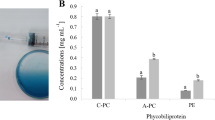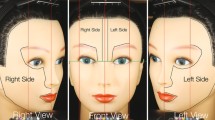Summary
Propionibacterium acnes was grown on Eagle's medium for 4–15 days at pH 5.3–7.2 The porphyrin production was measured both by direct fluorometry and by high pressure liquid chromatography (HPLC). The greatest concentration of porphyrins was produced at pH 6.1. Protoporphyrin was the dominant porphyrin species present in the bacteria in all samples. The relative amount of coproporphyrin was greatest at pH 6.7 after 4 days of incubation. In human skin there are local variations in the pH; therefore our findings may be of importance for porphyrin production in acne.
Similar content being viewed by others
References
Bogorad L (1979) Biosynthesis of porphyrins. In: Dolphin D (ed) The porphyrins, vol VI, pt A. Academic Press, New York, pp 125–178
Cornelius CE, Ludwig GD (1967) Red fluorescence of comedones: production of porphyrins by Corynebacterium acnes. J Invest Dermatol 49:368–370
Fanta D, Formanek I, Poitschek Ch, Thurner J (1978) Die Porphyrinproduktion des Propionibacterium acnes bei Acne und Seborrhoe. Arch Dermatol Res 261:175–179
Fanta D, Formanek I, Poitschek Ch, Thurner J (1981) Die Porphyrinproduktion des Propionibacterium acnes in Abhängigkeit von externen Einflüssen. Arch Dermatol Res 271:127–133
Formanek I, Fanta D, Poitschek Ch, Thurner J (1977) Porphyrinproduktion des Propionibacterium acnes. Arch Dermatol Res 259:169–176
Fuhrhop JH, Smith KM (1975) Laboratory methods in porphyrin and metalloporphyrin research. American Elsevier Publishing Co, New York, p 784
Holland DB, Cunliffe WJ (1982) Skin surface and open comedone pH in acne patients. Acta Derm Venereol (Stockh) 63:155–158
Holland KT, Cunliffe WJ, Roberts OD (1978) The role of bacteria in acne vulgaris: a new approach. Clin Exp Dermatol 3:253–257
Holland KT, Ingham E, Cunliffe WJ (1981) The microbiology of acne. J Appl Bacteriol 51:195–215
Husby P, Romslo I (1980) Studies on the efflux of metalloporphyrin from rat-liver mitochondria. Biochem J 188:459–465
Kishishita M, Ushijima T, Ozahi Y, Ito Y (1979) Biotyping of Propionibacterium acnes isolated from normal human facial skin. Appl Environ Microbiol 38:585–589
Lamola AA (1982) Fluorescence studies of protoporphyrin transport and clearance. Acta Derm Venereol (Stockh) Suppl 100:57–66
Lamola AA, Asher I, Muller-Eberhard U, Poh-Fitzpatrick M (1981) Fluorimetric study of the binding of protoporphyrin to haemopexin and albumine. Biochem J 196:693–698
Lee WS, Shalita AR, Poh-Fitzpatrick MB (1978) Comparative studies of porphyrin production in Propionibacterium acnes and Propionibacterium granulosum. J Bacteriol 133:811–815
McGinley KJ, Webster GF, Leyden JJ (1980) Facial follicular porphyrin fluorescence: correlation with age and density of Propionibacterium acnes. Br J Dermatol 102:437–441
Melø TB, Johnsson M (1982) In vivo fluorescence from Propionibacterium acnes. Dermatologica 3:167–174
Sandberg S, Glette J, Hopen G, Solberg CO, Romslo I (1981) Porphyrin-induced photodamage to isolated human neutrophils. Photochem Photobiol 34:471–475
Sandberg S, Romslo I (1981) Phototoxicity of protoporphyrin as related to its subcellular localization in mice livers after short-term feeding with griseofulvin. Biochem J 198:67–74
Schwartz S, Stephenson B, Freyholtz H, Ruth G (1980) Quantitative assay of erythrocyte “free”- and zinc-protoporphyrin: clinical and genetic studies. Int J Biochem 12:1053–1057
Author information
Authors and Affiliations
Rights and permissions
About this article
Cite this article
Kjeldstad, B., Johnsson, A. & Sandberg, S. Influence of pH on porphyrin production in Propionibacterium acnes . Arch Dermatol Res 276, 396–400 (1984). https://doi.org/10.1007/BF00413361
Received:
Issue Date:
DOI: https://doi.org/10.1007/BF00413361




